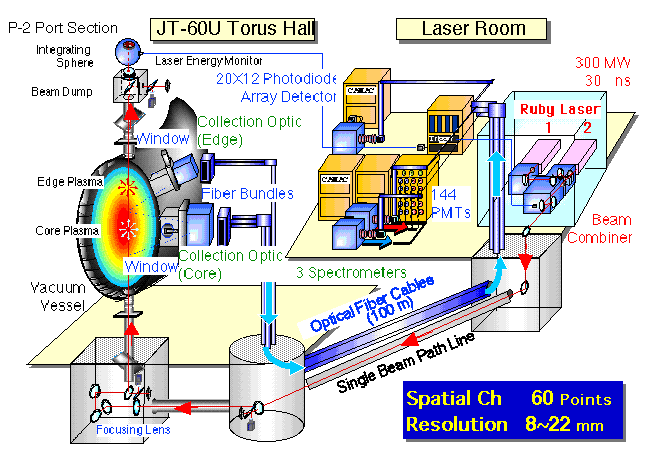Objectives
Spatial profile measurement of electron temperature (Te) and density (ne) of JT-60U plasma with high precision, resolution (8~22 mm), repetition (time interval: 0.002 to 2 second) and reliability.
[Detectors, Diagnostic Method]
Thomson scattering light of multiple ruby lasers obtained through collection optics, fiber optics and spectrometers is detected by 20x12 photodiode array (PDA) for high temperature core plasma and 144 photomultiplier tubes (PMTs) for low temperature edge plasma. Te and ne can be estimated through a non-linear least square fit of fully relativistic Thomson scattering spectrum to measured one reconstructed with the detector signals and calibration data.

Specification
(1) Parameters of ruby lasers, beam combiner, and beam optics
| - | Ruby Laser1 (PDS4, Lumonics) |
Ruby Laser 2 (PDS2s, Lumonics) |
| Ruby Lasers | ||
| energy (J) | 2.5, 5, 10, 20 | 10 |
| pulse interval (sec) | 1, 2, 4, single | 4 |
| pulse width (nsec) | 30 | 30 |
| divergence (mrad) | less than 300 | less than 300 |
| polarization | P | S |
| diameter (mm) | 26 | 22 |
| Beam Combiner | ||
| polarizer plate | transmission | reflection |
| Faraday rotation angle | 90 degree | none |
| total energy loss | less than 5% | less than 2% |
| Faraday rod | ||
| dimension (mm) | 45f x 40length | - |
| Verdet const. (min./Oe/cm) | -0.242 at 632.8 nm | - |
| solenoid coil | ||
| dimension (mm) | 64f x 197length | - |
| coil current (A) | ~750 | - |
| number of turns | 150 | - |
| minimum time delay against PDS4 (ms) | - | 2 |
| Beam Optics | ||
| number of bending mirrors | 8, including three computer-controlled mirror gimbals for adjusting a single beam path line | |
| focusing lens | f/9.75m (beam diameter in vessel : 3~7 mm) | |
| beam dump | colored filter glass | |
| energy monitor | ||
| components | integrating sphere with ND filter and Fresnel lens, optical fiber PIN photodiode, and gated ADC/memory |
|
| location | just after beam combiner (input side) and just after beam dump (output side) | |
(2) Parameters of vacuum hardware, collection optics, fiber optics, and alignment system.
-Edge Plasma MeasurementCore Plasma MeasurementVacuum Hardwarewindow size (mm)260f x 20t260f x 30t remote controlled shutteryesyesviewing dumpfine ditched graphitefine ditched graphiteCollection Opticstypedouble Gaussian type lensCassegrain type reflection mirroreffective field of view18 degree46 degreespan of measurement (m)~0.7~1.4spatial resolution (mm)8, 1622F number2.1-focal length (mm)340225.57magnification-0.22-0.16transmission90%75%solid angle (sr)0.00650.0055Fiber Opticscore/clad diameter ( mm)180/200, quartz180/200, quartzI/O bundle size (mm)1.73hx1.59w and 0.80h x3.50w
3.50hx1.42w and 1.50h x3.40w3.50hx1.07w and 1.60h x2.40wNA~0.3~0.3length (m)104104transmission (He-Ne)45~50%45~50%measurement bundles3030alignment bundles4(2x2)4(2x2)Alignment System for object field of collection fiber opticsparallel correction (Bt direction)-6.5 mm to +6.5 mm (0.001mm step)-5.5 mm to +5.5 mm (0.001mm step) rotation correction on optical axis-6.5 degree to +6.5 degree (0.001 degree step)-3.5 degree to +3.5 degree (0.001 degree step) function of regular monitor and
auto-recovery through direct and
quantitative procedureyesyesfor beam optics
remote correction through the following procedure:
(1) monitoring beam position on target screen detected by CCD cameras
(2) adjusting beam line to prescribed path through three computer-controled mirror gimbals
(3) Parameters of spectrometers and coupling optics
-Edge Plasma MeasurementCore Plasma MeasurementSpectrometerstypeLittrow x 1 (for PMT system)Littrow x 2 (for PMT & PDA systems)F number2.92.9focal length (mm)275275grating (1/mm)1200600grating size (mm)97x10097x100 output image size (mm)60.0hx51.3w60.0hx51.3w spectral resolution of PMT4~56 spectral resolution of PDA-12spectral range (nm)550~688403~683Fiber Bundles from Spectrometer to PMTscoreglassglassclad diameter ( mm)5050NA0.570.57length ( m)~2.3~2.5transmission50~60%50~60%number of bundles130 ch [spatially 30 and spectrally (4~5) ]60 ch [spatially 10 and spectrally 6 ]Wavelength Cutoff Glass for Core Plasma Measurement by PDA Systemwidth in dispersion direction-4.0 mm for Ruby (694.3 nm)
4.0 mm for Ha /Da emission
3.8 mm for Hb /Db emissionCoupling Lens for Core Plasma Measurement by PDA Systemfield lens & collimator lens-achromat lens (made to order)focusing lens-Noct Nikkor 58mm/F1.2S
(4) Parameters of PDA/PMT detector systems.
-PMT System for Edge &
Core Plasma MeasurementPDA System for
Core Plasma MeasurementDetectorsphotomultiplier tube
(R943/R1387, Hamamatsu Photonics)2-D photodiode array (PDA) with
proximity focused type image intensifier photocathode size(mm)10 x 10 (GaAs)
34f (S-20) partially used for core measurement25f (S-20, multialkali)photodiode size (mm)-17.42 x 13.84 quantum efficiency photocathode0.13(400~700 nm) for GaAs
0.16 (400 nm), 0.09 (540 nm) for S-200.16 at 400 nm, 0.03 at 694.3 nmphotodiode-0.93 at 400 nm (peak wavelength of P-47)phosphor decay time (nsec)-210 (P-47), up to 5% residual intensityADC gate width (nsec)125 (ADC)125 (Photocathode - MCP)A/D conversion bits( 11 in LeCroy 4301B)12A/D conversion time ( msec)(~10 in LeCroy 4301B)max. 3data transfer time ( msec)-480 (signal 240 ch + background 240ch)number of elementsfor edge measurement130 PMTs = spatially 30 x spectrally (4~5)-for core measurement60 PMTs = spatially 10 x spectrally 6240 ch /unit = spatially 20 x spectrally 12dynamic rangemore than 105~103
References
[1] H. Yoshida, et al., "JT-60U Thomson scattering system with multiple ruby lasers and high spatial resolution for high electron temperature plasma measurement ", JAERI-Research 96-061; 1996, 20p.
[2] H. Yoshida, et al., "Beam Combiner for Transient Phenomena Measurement in the JT-60 Thomson Scattering Diagnostic", Rev. Sci. Instrum. Vol. 66, 143~147 (1995).
[3] H. Yoshida, et al., "Quantitative method for precise, quick and reliable alignment of collection object fields in the JT-60U Thomson scattering diagnostic", Rev. Sci. Instrum. Vol. 68, 1152~1161 (1997).
[4] H. Yoshida, et al., "Approach to a window coating problem by in-situ transmission monitoring and laser blow-off cleaning developed in the JT-60U Thomson scattering system", Rev. Sci. Instrum. Vol. 68, 256~257 (1997).
[5] H. Yoshida, et al., "Solution for a window coating problem developed in the JT-60U Thomson scattering system", JAERI-Research 96-062; 1996, 25p.
[6] O. Naito, et al., "Analytic formulation for fully relativistic Thomson scattering spectrum", Phys. Fluids B Vol. 5, 4256~4258 (1993).
[7] O. Naito, et al., "Relativistic incoherent Thomson scattering spectrum for generalized Lorentzian distributions", Phys. Plasmas Vol. 3, 1474~1476 (1995).
[8] O. Naito, et al., "A formula for reconstructing fully relativistic electron distributions from incoherent Thomson scattering data", Phys. Plasmas Vol. 4, 1171-1172 (1997).
[9] H. Yoshida, O. Naito, O. Yamashita, S. Kitamura, T. Sakuma, Y. Onose, H. Nemoto, T. Hamano, T. Hatae, A. Nagashima, and T. Matoba, "Multilaser and high spatially resolved multipoint Thomson scattering system for the JT-60U tokamak", Rev. Sci. Instrum. Vol. 70, 751~754 (1999).
[10] H. Yoshida, O. Naito, T. Sakuma, S. Kitamura, T. Hatae, and A. Nagashima, "A compact and high repetitive photodiode array detector for the JT-60U Thomson scattering diagnostic", Rev. Sci. Instrum. Vol. 70, 747~750 (1999).
[11] O. Naito, H. Yoshida, S. Kitamura, T. Sakuma, and Y. Onose, "How many wavelength channels do we need in Thomson scattering diagnostics?", Rev. Sci. Instrum. Vol. 70, 3780~3781 (1999).

